Engine PONTIAC GRAND AM 2003 Manual Online
[x] Cancel search | Manufacturer: PONTIAC, Model Year: 2003, Model line: GRAND AM, Model: PONTIAC GRAND AM 2003Pages: 354, PDF Size: 16.3 MB
Page 270 of 354
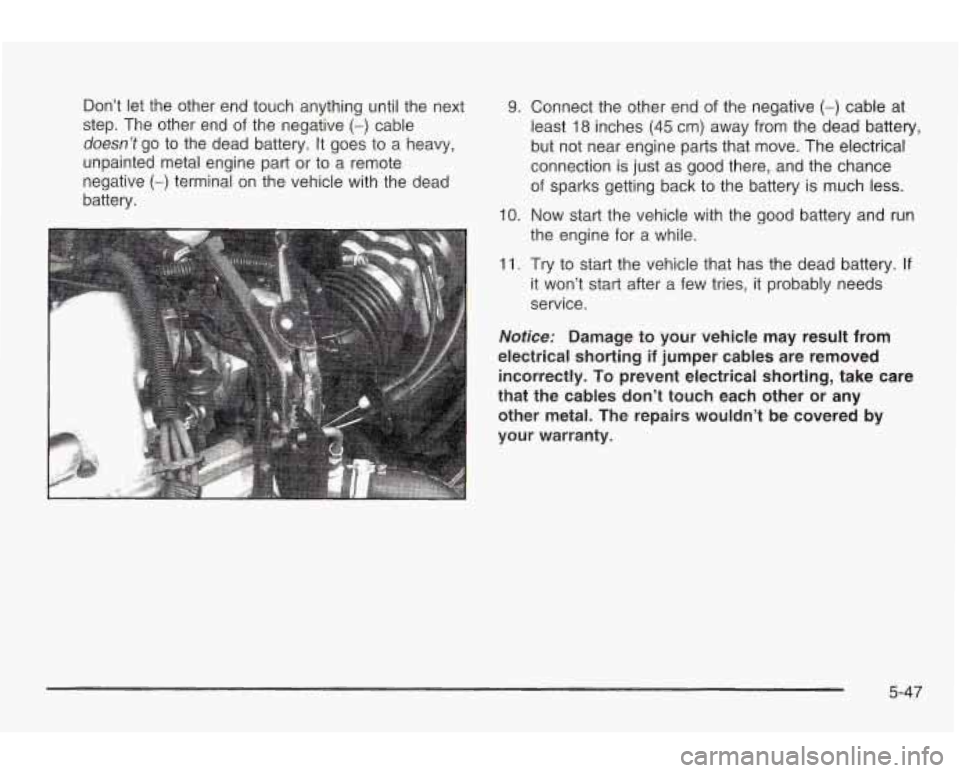
Don’t let the other end touch anything until the next
step. The other end of the negative
(-) cable
doesn’t go to the dead battery. It goes to a heavy,
unpainted metal engine part or to a remote
negative
(-) terminal on the vehicle with the dead
battery.
9.
10.
11.
Connect the other end of the negative (-) cable at
least 18 inches
(45 cm) away from the dead battery,
but not near engine parts that move. The electrical
connection is
just as good there, and the chance
of sparks getting back to the battery
is much less.
Now start the vehicle with the good battery and run
the engine for a while.
Try to start the vehicle that has the dead battery. If
it won’t start after a few tries, it probably needs
service.
Notice: Damage to your vehicle may result from
electrical shorting if jumper cables are removed
incorrectly.
To prevent electrical shorting, take care
that the cables don’t touch each other or any
other metal. The repairs wouldn’t be covered by
your warranty.
5-47
Page 271 of 354
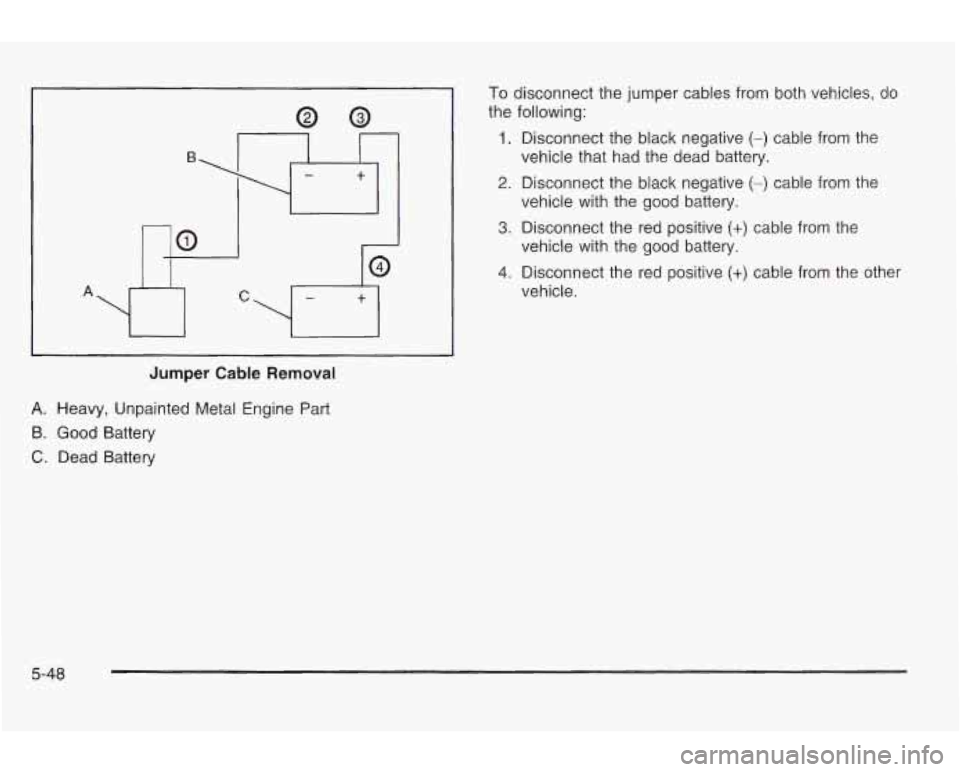
r
B
I1
Jumper Cable Removal
A. Heavy, Unpainted Metal Engine Part
B. Good Battery
C. Dead Battery
To disconnect the jumper cables from both vehicles, do
the following:
1. Disconnect the black negative (-) cable from the
2. Disconnect the black negative (-) cable from the
3. Disconnect the red positive (+) cable from the
4. Disconnect the red positive (+) cable from the other
vehicle that
had the dead battery.
vehicle with the good battery.
vehicle with the good battery.
vehicle.
5-48
Page 285 of 354
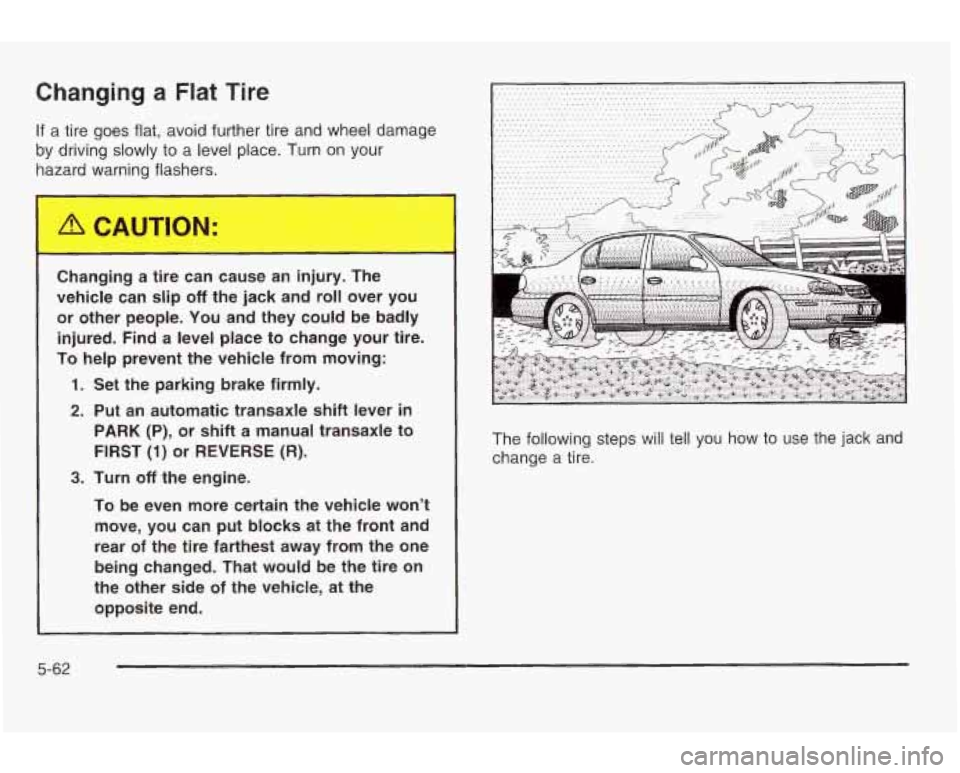
Changing a Flat Tire
If a tire goes flat, avoid further tire and wheel damage
by driving slowly to
a level place. Turn on your
hazard warning flashers.
Changing a tire can cause an injury. The
vehicle can slip
off the jack and roll over you
or other people. You and they could be badly
injured. Find a level place to change your tire.
To help prevent the vehicle from moving:
1. Set the parking brake firmly.
2. Put an automatic transaxle shift lever in
PARK (P), or shift a manual transaxle to
FIRST
(1) or REVERSE (R).
3. Turn off the engine.
To be even more certain the vehicle won’t move, you can put blocks at
the front and
rear
of the tire farthest away from the one
being changed. That would be the tire on other side of the vehicle, at the The following steps
will tell you how to use the jack and
change a tire.
5-62
Page 303 of 354
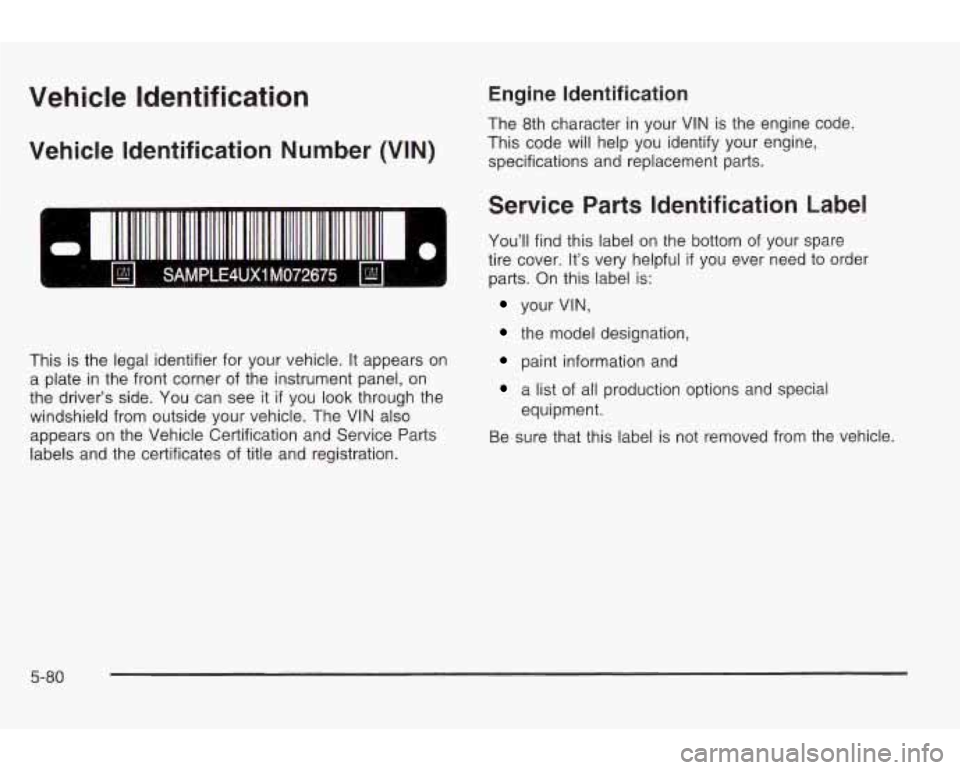
Vehicle Identification
Vehicle Identification Number (VIN)
This is the legal identifier for your vehicle. It appears on
a plate in the front corner
of the instrument panel, on
the driver’s side. You can see
it if you look through the
windshield from outside your vehicle. The VIN also
appears on the Vehicle Certification and Service Parts
labels and the certificates of title and registration.
Engine Identification
The 8th character in your VIN is the engine code.
This code will help you identify your engine,
specifications and replacement parts.
Service Parts Identification Label
You’ll find this label on the bottom of your spare
tire cover. It’s very helpful
if you ever need to order
parts. On this label is:
your VIN,
the model designation,
paint information and
a list of all production options and special
equipment.
Be sure that this label is not removed from the vehicle.
5-80
Page 304 of 354
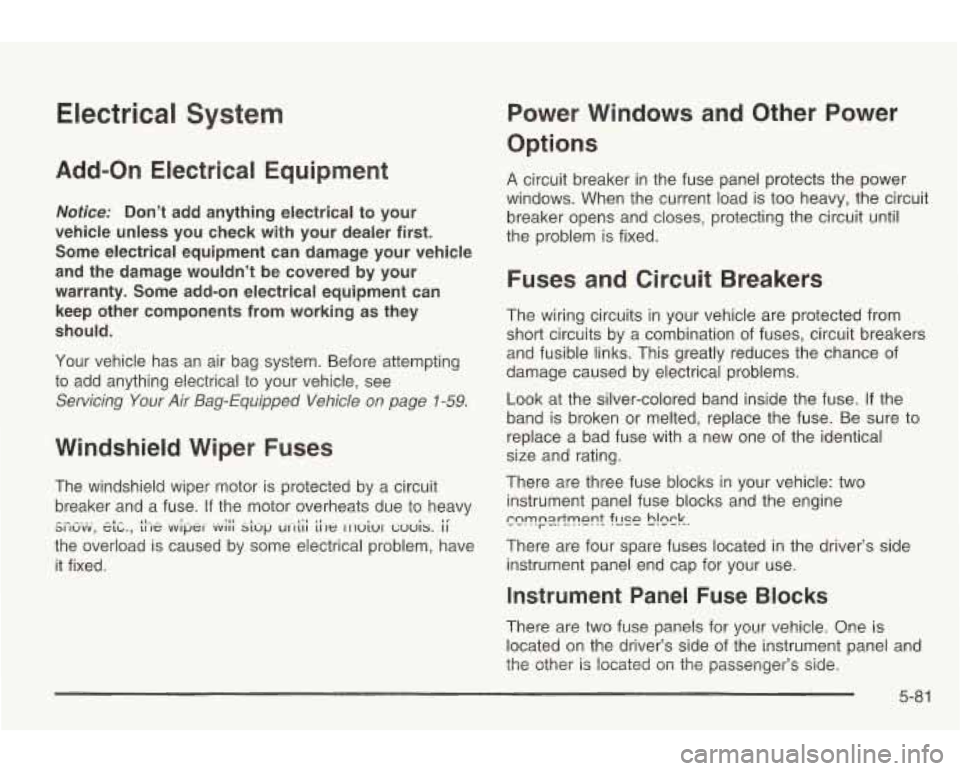
Electrical System
Add-On Electrical Equipment
Notice: Don’t add anything electrical to your
vehicle unless you check with your dealer first.
Some electrical equipment can damage your vehicle
and the damage wouldn’t be covered by your
warranty. Some add-on electrical equipment can
keep other components from working as they
should.
Your vehicle has an air bag system. Before attempting
to add anything electrical to your vehicle, see
Servicing Your Air Bag-Equipped Vehicle on page 1-59.
Windshield Wiper Fuses
The windshield wiper motor is protected by a circuit
breaker and a fuse. If the motor overheats due to heavy
the overload is caused by some electrical problem, have
it fixed.
SXLY, ek., the vvipec vviii Sup urliii iikle I~IIU~WI cuuis. ii
Power Windows and Qther Power
Options
A circuit breaker in the fuse panel protects the power
windows. When the current load is
too heavy, the circuit
breaker opens and closes, protecting the circuit until
the problem is fixed.
Fuses and Circuit Breakers
The wiring circuits in your vehicle are protected from
short circuits by a combination
of fuses, circuit breakers
and fusible links. This greatly reduces the chance of
damage caused by electrical problems.
Look at the silver-colored band inside the fuse.
If the
band is broken or melted, replace the fuse. Be sure
to
replace a bad fuse with a new one of the identical
size and rating.
There are three fuse blocks in your vehicle: two
instrument panel fuse blocks and the engine
rmpsrtment !LE? h!r\Ck.
There are four spare fuses located in the driver’s side
instrument panel end cap for your use.
Instrument Panel Fuse Blocks
There are two fuse panels for your vehic!~. One Is
located on the driver’s side of the instrument panel
the other
is located on the passenger’s side. and
5-81
Page 307 of 354

Engine Compartment Fuse Block
The engine compartment fuse block is located on the
driver’s side
of the engine compartment, near the
battery.
.
Fuse
1
2
Usage
Ignition Switch
Right Electrical Center-Fog Lamps,
Radio, Body Function Control
Module, Interior Lamps Fuse
3
4
5
6
7
8
Relays
9
10
11
12
13
14
15 Usage
Left Electrical Center-Stop Lamps,
Hazard Lamps, Body Function
Control Module, Cluster, Climate
Control System
Anti-Lock Brakes
Left Electrical Center-Power Seats,
Power Mirrors, Door Locks, Trunk
Release, Audio Amplifier, Remote
Keyless Entry
Not Used Ignition Switch
Cooling Fan
#I
Usage
Rear Defog
Not Used
Starter
Cooling Fan #1
HVAC Blower (Climate Control)
Cooling Fan #2
Cooling Fan
5-84
Page 309 of 354

Capacities and Specifications
All capacities are approximate. When adding, be sure to fill to the appropriate level or as recommended in
this manual.
Capacities
I Capacities
Application
0.6 kg 1.4
Ibs.
Metric
English
Air Conditioning Refrigerant R134a
Use Refrigerant Oil, R134a Systems
Automatic Transaxle
Complete Overhaul
9.0 L
9.5 quarts
Cooling System
2.2L
L4 t Engine
3400 V6 Engine 8.6 quarts
13.6 quarts 8.2
L
12.9 L
Engine Oil with Filter
2.2L L4
t Engine
3400 V6 Engine 5.0 quarts
4.5 quarts 4.8 L
4.3 L
Fuel Tank
53.4 L 14.1
gallons
5-86
Page 310 of 354

Capacities (cont’d)
Manual Transaxle
Complete Overhaul 1.7 L
See Part D: Recommended Fluids and Lubricants on page 6-15.
Engine SDecifications -
42 inch (1.06 rnrn
5-87
Page 311 of 354

Normal Maintenance Replacement Parts
Part
Engine Air Cleaner/Filter
2.2 L L4t Engine
3400 V6
Engine
Oil Filter
2.2 L L4t Engine
3400 V6
PCV Valve Spark Plugs 2.2
L L4 t Engine
3400 V6
Windshield Wiper Blades
Type Passenger’s Side
Driver’s Side
*ACDelco@ part number. Number
AI 172C*
AI 279C*
PF2244G* PF47*
CV892C*
41-981
* (Platinum Plug)
41-1
01 * (Platinum Plug)
Shepherd’s
Hook
17.0 inches (43.0 cm)
22.0 inches (56.0 cm)
tECOTECTM
5-88
Page 312 of 354
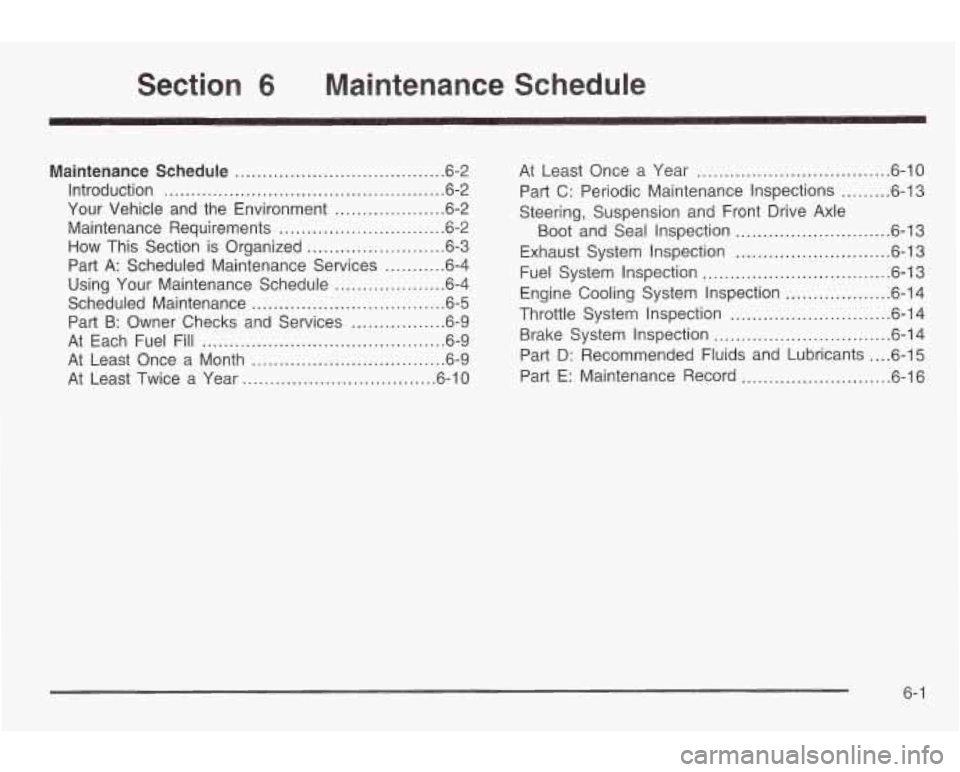
Section 6 Maintenance Schedule
Maintenance Schedule ...................................... 6.2
Introduction
................................................... 6.2
Your Vehicle and the Environment
.................... 6-2
Maintenance Requirements
.............................. 6-2
How This Section is Organized
......................... 6-3
Part A: Scheduled Maintenance Services
........... 6-4
Using Your Maintenance Schedule
.................... 6-4
Scheduled Maintenance
................................... 6-5
Part
6: Owner Checks and Services ................. 6-9
At Each Fuel Fill ............................................ 6-9
At Least Once a Month
................................... 6-9
At Least Twice a Year
................................... 6-10 At
Least Once a Year
................................... 6.10
Part
C: Periodic Maintenance Inspections ......... 6.13
Steering, Suspension and Front Drive Axle
Boot and Seal Inspection ............................ 6-13
Exhaust System Inspection
............................ 6.13
Fuel System Inspection
.................................. 6.13
Engine Cooling System Inspection
................... 6.14
Throttle System Inspection
............................. 6.14
Brake System Inspection
................................ 6.14
Part
D: Recommended Fluids and Lubricants .... 6-15
Part
E: Maintenance Record ........................... 6.16
6-1